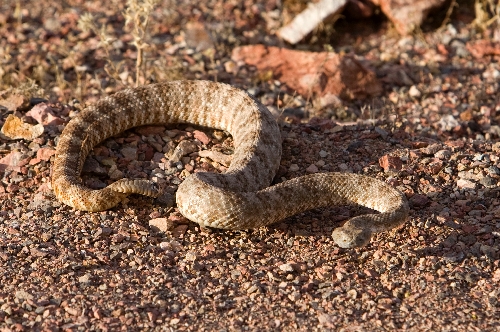Residents should be wary of rattlesnakes on trails near rural areas


For about eight years, Henderson resident Bill Samuels has run on the River Mountains Loop Trail with his boxer, Harley .
All that changed when Harley was struck on the forehead by a 3-foot-long rattlesnake June 6.
“I was running with my dog, and she noticed something,” Samuels said. “I thought it was a squirrel. Then she laid down, and I noticed it was a snake.”
Samuels killed the snake to protect his dog.
Harley was taken to a veterinarian’s office, given antivenom and kept overnight for observation. About $1,200 later, Harley is home recovering.
“I won’t take her on the trail again,” Samuels said, “a t least not until winter.”
It was the second time Samuels had seen a snake on a trail.
“The first time, it was right after it rained,” Samuels said. “I attributed it to the rain.”
Samuel said many of his neighbors have noticed more snakes going across the pathways.
There are three types of rattlesnakes in the Las Vegas area, according to Michael Burroughs, a wildlife biologist with the U.S. Fish and Wildlife Service : the speckled, which can grow to 2 to 3 feet long; the sidewinder, which can grow to between 18 and 24 inches long; and the M ojave, which can grow to 3 feet or longer.
“The M ojave is the most venomous out of all of them,” Burroughs said. “But you also have to watch out for the neonate (or newborn) snakes. They can be equally as dangerous.”
During the summer, Burroughs said, the snakes are most active in the morning.
“Not to say the only risk (of encountering snakes) is in the morning,” Burroughs said. “Just have a greater awareness when walking around.”
Burroughs said rattlesnakes such as the speckled tend to live near hills and climbing areas.
“With the higher temperatures, they are likely to retreat to shelter,” Burroughs said. “Be very aware of where you put your hand (if climbing). Avoid putting your hand into crevasses, which (snakes) can use as shelter.”
Burroughs recommends staying on trails. However, snakes still can be found on the paths, coiled up like a rock.
“Hiking with pets is a whole other level,” Burroughs said. “Dogs like to explore, stick their heads places and smell around. They are at a greater risk of being bitten. It is often in the head. The cost of treating (your pet) can be very costly.”
In general, Burroughs said snakes can be aggressive on the defensive side.
“You could step on them and startle them, (causing them to strike),” Burroughs said. “Dogs might pose a threat just because they mimic other natural predators such as the coyote.”
Regardless, Samuels hopes to see signs warning people that there might be snakes on the trail or crossing the path.
“I know everything costs money,” Samuels said. “But the money I spent to fix my dog easily could have gone to half of the signs.”
Samuels said signs might not be just for the community but also for runners and bicyclists who don’t live in the area and are unaware that rattlesnakes might be out there.
Kim Becker, a spokeswoman with the Henderson Parks and Recreation Department , said the city does have signs to warn people that they might see more snakes this time of year.
“In general, rattlesnakes might be spotted on the Anthem East Trail and River Mountains Loop Trail as they are more rural areas,” Becker said. “We occasionally have a rattlesnake in the basin area at Anthem Hills Park. We do have signage out there to let people know that they may see snakes and to leave them alone if they do see one. We ask that anyone using our trails please leave wildlife alone. It’s also another reason why pets on our trails must be leashed.”
But a sign doesn’t mean everything.
“Just because there are no signs doesn’t mean there are no snakes,” Burroughs said.
Contact Henderson and Anthem View reporter Michael Lyle at mlyle@viewnews.com or 387-5201.
Rattlesnake SafetyPrevention is key when it comes to avoiding encounters with rattlesnakes in areas surrounding the Las Vegas Valley.
Rattlesnake bites are not uncommon locally, with most attacks occurring in the evening or early morning hours, according to Las Vegas Animal Emergency Hospital, 5231 W. Charleston Blvd.
As the temperature cools, such as in the evening hours, rattlesnakes become more active. The snakes function best between 70 degrees and 90 degrees Fahrenheit.
Hikers and dogs are most likely to encounter snakes. However, urban encroachment has brought snakes and residents into closer proximity, increasing sightings and snake bites.
A rattlesnake vaccine is available locally, and once a bite occurs, treatment is required immediately.
Although antivenin is not 100 percent effective, it has been reported to delay the effects and reduce the severity of rattlesnake bites.
The vaccine helps dogs survive and recover more quickly with less pain and swelling.
Signs your dog has been bitten by a rattlesnake:
Puncture wounds; Swelling; Pain; Redness or blackened flesh.
Symptoms can occur within 30 minutes and up to 24 hours following a rattlesnake bite. Envenomentation can lead to death.
Areas prone to rattlesnakes that should be avoided:
Rocky regions; Crevices; Dwellings; Caves; Slopes; Mines
LAS VEGAS ANIMAL EMERGENCY HOSPITAL












